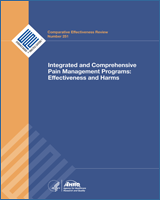NCBI Bookshelf. A service of the National Library of Medicine, National Institutes of Health.
Skelly AC, Chou R, Dettori JR, et al. Integrated and Comprehensive Pain Management Programs: Effectiveness and Harms [Internet]. Rockville (MD): Agency for Healthcare Research and Quality (US); 2021 Oct. (Comparative Effectiveness Review, No. 251.)

Integrated and Comprehensive Pain Management Programs: Effectiveness and Harms [Internet].
Show detailsKey Question 1
Figure I-1. IPMP versus UC: SF-36 or SF-12 PCS at postintervention, short term and long term
Figure I-2. IPMP versus UC: SF-36 or SF-12 MCS at postintervention, short term and long term
Figure I-3. IPMP versus UC: Depression at postintervention
Figure I-4. CPMP versus UC: Sensitivity analysis for pain excluding poor quality trials
Figure I-7. CPMP versus UC: Sensitivity analysis for pain excluding the MPQ
Figure I-8. CPMP versus UC: Sensitivity analysis for function excluding an outlier trial
Figure I-9. CPMP versus UC: Sensitivity analysis for function excluding poor-quality trials
Figure I-12. CPMP versus UC: Pain interference
Figure I-13. CPMP versus UC: SF-36 PCS
Figure I-14. CPMP versus UC: SF-36 MCS
Figure I-15. CPMP versus UC: Depression
Figure I-16. CPMP versus UC: Sensitivity analysis for depression excluding poor-quality trials
Figure I-18. CPMP versus UC: Anxiety
Figure I-19. CPMP versus UC: Sensitivity analysis for anxiety excluding the poor-quality trial
Figure I-23. CPMP versus physical activity: Leg pain
Figure I-26. CPMP versus physical activity: SF-36 or SF-12 PCS
Figure I-28. CPMP versus physical activity: SF-36 or SF-12 MCS
Figure I-30. CPMP versus physical activity: Depression
Figure I-33. CPMP versus physical activity: Anxiety
Figure I-38. CPMP versus psychological therapy alone: Depression
Key Question 2
Figure I-40. CPMP with greater versus fewer total hours: Pain at intermediate term
Figure I-42. CPMP with greater versus fewer total hours: Function at intermediate term
Figure I-44. CPMP with greater versus fewer total hours: Depression at intermediate term
Figure I-46. CPMP conducted in an inpatient versus outpatient setting: Pain at short and long term
Figure I-52. CPMP with versus without additional psychological components: Pain at postintervention
- Forest Plots - Integrated and Comprehensive Pain Management Programs: Effectiven...Forest Plots - Integrated and Comprehensive Pain Management Programs: Effectiveness and Harms
- Quality Assessment Form - Interventions for Adolescents and Young Adults With Au...Quality Assessment Form - Interventions for Adolescents and Young Adults With Autism Spectrum Disorders
- Peromyscus maniculatus voucher JFS144 haplotype A gamma-globin subunit (HBG-T1) ...Peromyscus maniculatus voucher JFS144 haplotype A gamma-globin subunit (HBG-T1) gene, complete cdsgi|350605683|gb|JN711327.1|Nucleotide
- Peromyscus maniculatus voucher JFS142 haplotype A gamma-globin subunit (HBG-T1) ...Peromyscus maniculatus voucher JFS142 haplotype A gamma-globin subunit (HBG-T1) gene, complete cdsgi|350605675|gb|JN711323.1|Nucleotide
- transmembrane channel-like protein 8 isoform C [Mus musculus]transmembrane channel-like protein 8 isoform C [Mus musculus]gi|32469503|ref|NP_862904.1|Protein
Your browsing activity is empty.
Activity recording is turned off.
See more...